
(Click on any image below for a larger version)
Wednesday, January 17
We received our wake-up call at 3:00 in the morning. After quick showers we headed down to the breakfast buffet, where the cruise passengers were assembling.
We piled into the buses for a short ride to the National Airport. Many of the passengers lined up at the gate in preparation to board the airplane, but it would be over an hour before boarding began. Eventually they herded us out the door to a row of waiting buses. Our bus circumnavigated the flightline, coming to a stop in front of our chartered LAPA 737-700.
The sun was just coming up as the airplane taxied to the runway. It taxied past the National Air Museum. They have a reasonably large collection of airplanes in a grassy field next to the airport. The collection includes an Avro Lincoln, Gloster Meteor, Junkers Ju-52, and an Argentine Pucacha twin turbo-prop, attack airplane that saw combat in the Falklands war.
The flight to Ushuaia in Tierra del Fuego took three hours. Some parts of it were as turbulent as any flight I have ever been on. Much of the flight was over clouds and we did not see the terrain below until we were descending to land.
Information about Tierra del Fuego.
We landed on a runway that is big enough to handle a Concorde. We were directed through the terminal building to another line of waiting buses. Ushuaia was nestled in the foothills of snow-covered mountains. The tree-line was just a couple of thousand feet above sea level.
Three buses took the charter flight passengers into the town. We passed a monument to the Argentine casualties of the battle for the Islas Malvinas (Falkland Islands).
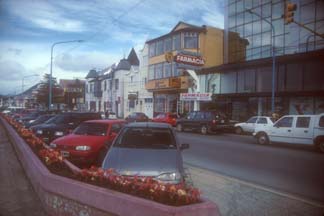 We were
given an hour and a half to check the town out.
We were
given an hour and a half to check the town out.
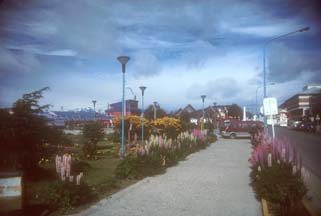 Most of
the yards and the park next to the harbor were landscaped with
large and brightly colored lupens. I headed for the post office
to buy stamps and mail postcards. Then I found a shop where I
could buy a map of Argentina, Chile, and the Islas Malvinas.
Most of
the yards and the park next to the harbor were landscaped with
large and brightly colored lupens. I headed for the post office
to buy stamps and mail postcards. Then I found a shop where I
could buy a map of Argentina, Chile, and the Islas Malvinas.
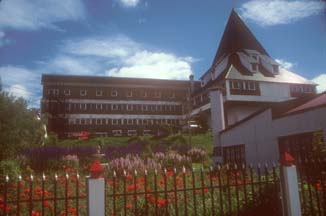 The
Government House in Ushuaia, Argentina
The
Government House in Ushuaia, Argentina
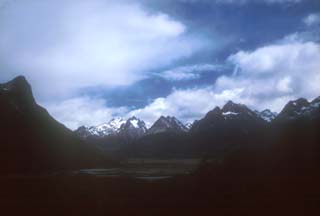 We
climbed back into the buses to drive to a chalet in the mountains
for a lamb barbecue.
We
climbed back into the buses to drive to a chalet in the mountains
for a lamb barbecue.
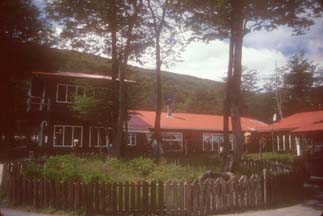 The barbecue area was around behind the chalet.
The barbecue area was around behind the chalet.
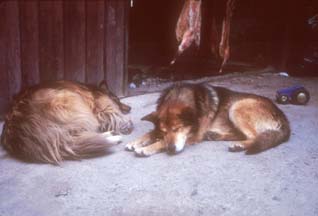 Entire lamb carcasses were staked out next to a large pit of
burning charcoal. A pair of Huskies was lying on the ground next
to the barbecue, paying no attention to the lamb cooking a few
steps away.
Entire lamb carcasses were staked out next to a large pit of
burning charcoal. A pair of Huskies was lying on the ground next
to the barbecue, paying no attention to the lamb cooking a few
steps away.
At the end of the meal, the proprietor of the chalet conducted a coffee making ritual. He prepared a large copper kettle with hot water and coffee grounds. He made a big show of pulling a hot coal out of the fireplace and putting it in the pot with the coffee. It was supposed to make the grounds settle to the bottom. Then he poured in a surprising variety of liqueurs and aperitifs. The coffee was doled out into small cups for the crowd. It tasted more like an after-dinner drink more than a cup of coffee.
More Huskies were kept in a fenced area under the trees. Each Husky was roped to a large stake. The dogs had worn a deep rut in a circle around each stake by running around and around.
After lunch we were driven up a winding dirt road to a pass through the southern end of the Andes Mountains overlooking Lake Escondido (Hidden Lake). Smoke was rising from a Beech tree lumbermill next to Lake Fagnano in the distance.
Along the way we passed several large beaver dams. Beavers are not indigenous to South America. They were introduced for their fur, but now their introduction is considered an environmental disaster. The lakes behind their dams drown the roots of the trees along the rivers, leaving large stands of dead and dying trees in the valleys.
We drove down from the pass to the Hotel Petrel on the shore of the lake. A Crested Caracara (a type of fish eating eagle) took off from a tree as we drove down the drive to the hotel.
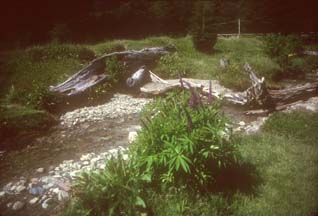 A small stream crossed the hotel property and
flowed into the lake. Upland Geese were foraging along the
lakeshore. Clouds blew in from over the pass, and a light rain
began. We went inside the pub to write postcards while we waited
for the bus.
A small stream crossed the hotel property and
flowed into the lake. Upland Geese were foraging along the
lakeshore. Clouds blew in from over the pass, and a light rain
began. We went inside the pub to write postcards while we waited
for the bus.
The bus ride back to Ushuaia was like the prelude to a two-paragraph, third-world bus crash article in a newspaper. The driver raced over the winding mountain road like his life depended on not being late to the boat. In places the wheels of the bus just barely skirted past the edge of the ruts eroded at the turns. The passenger in front of me kept his back to the window and occasionally shut his eyes to avoid seeing the steep drop next to the road. The driver actually passed two other buses on the road.
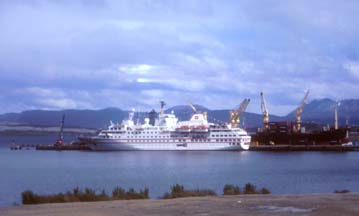 We
exited the bus and climbed the gangway into the ship. Our ship
was the MV Hanseatic. It was built for the purpose of conducting
expedition cruises in the Arctic and Antarctic. It has the
highest ice rating of any cruise ship, although it isn't an
ice-breaker. It is registered in Nassau and the crew is German.
It carried only 170 passengers on this cruise.
We
exited the bus and climbed the gangway into the ship. Our ship
was the MV Hanseatic. It was built for the purpose of conducting
expedition cruises in the Arctic and Antarctic. It has the
highest ice rating of any cruise ship, although it isn't an
ice-breaker. It is registered in Nassau and the crew is German.
It carried only 170 passengers on this cruise.
Link to the Radisson pages describing the MV Hanseatic.
We were immediately escorted to our stateroom on the Marco Polo deck. It was much bigger than a typical cruise ship cabin. In addition to a pair of beds, it featured a couch on one wall, a desk on the opposite wall, and a table in the center of the room. The window was quite big, providing an expansive view of the harbor. Under the desk there was a refrigerator loaded with complimentary sodas and juices. There was also a VCR and television. The room had three large closets and lots of drawers. The bathroom was equipped with a real bathtub, not just a coffin-sized shower. A blow dryer was attached to the wall next to the mirror. The blow dryer turned out to be a necessity after each of our landings.
Our luggage was already waiting for us. We spent a while pulling our clothes and cold weather gear out of our luggage and finding places to store everything.
An introductory tea was provided in the Explorer Lounge on the next deck up from our stateroom. The obligatory lifeboat drill was conducted at 6:00 P.M. We all put on our life preservers and assembled in the Columbus Lounge, two decks up. The ship's staff briefed us on what to do in the event of an emergency. An Argentine immigration official was stamping our passports and exit visas at a table in the corner. After the briefing, we were escorted up to the lifeboat assembly area in a light, cold drizzle.
Dinner was at 8:00 in the Marco Polo Restaurant, on the same deck as our stateroom. Like all the dinners, it was a leisurely affair consisting of a cold appetizer, soup, hot appetizer, sherbet, entrée, and desert that lasted nearly two hours.
After dinner, I donned some warm clothes, grabbed my camera gear and headed up to the observation deck above the bridge to shoot pictures of the harbor and our departure. Promptly at 10:00, the ship started moving forward so gently that I wasn't immediately aware that we were underway until I saw the dock slipping away behind us.
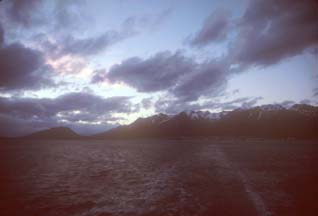 We started
down the Beagle Channel toward the South Atlantic Ocean as the
sun was setting behind the mountains.
We started
down the Beagle Channel toward the South Atlantic Ocean as the
sun was setting behind the mountains.
 Table of Contents
Table of Contents  Send
a message to Brian.
Send
a message to Brian.